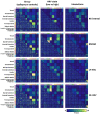Altered Relationship Between Heart Rate Variability and fMRI-Based Functional Connectivity in People With Epilepsy
- PMID: 34177777
- PMCID: PMC8223068
- DOI: 10.3389/fneur.2021.671890
Altered Relationship Between Heart Rate Variability and fMRI-Based Functional Connectivity in People With Epilepsy
Abstract
Background: Disruptions in central autonomic processes in people with epilepsy have been studied through evaluation of heart rate variability (HRV). Decreased HRV appears in epilepsy compared to healthy controls, suggesting a shift in autonomic balance toward sympathetic dominance; recent studies have associated HRV changes with seizure severity and outcome of interventions. However, the processes underlying these autonomic changes remain unclear. We examined the nature of these changes by assessing alterations in whole-brain functional connectivity, and relating those alterations to HRV. Methods: We examined regional brain activity and functional organization in 28 drug-resistant epilepsy patients and 16 healthy controls using resting-state functional magnetic resonance imaging (fMRI). We employed an HRV state-dependent functional connectivity (FC) framework with low and high HRV states derived from the following four cardiac-related variables: 1. RR interval, 2. root mean square of successive differences (RMSSD), 4. low-frequency HRV (0.04-0.15 Hz; LF-HRV) and high-frequency HRV (0.15-0.40 Hz; HF-HRV). The effect of group (epilepsy vs. controls), HRV state (low vs. high) and the interactions of group and state were assessed using a mixed analysis of variance (ANOVA). We assessed FC within and between 7 large-scale functional networks consisting of cortical regions and 4 subcortical networks, the amygdala, hippocampus, basal ganglia and thalamus networks. Results: Consistent with previous studies, decreased RR interval (increased heart rate) and decreased HF-HRV appeared in people with epilepsy compared to healthy controls. For both groups, fluctuations in heart rate were positively correlated with BOLD activity in bilateral thalamus and regions of the cerebellum, and negatively correlated with BOLD activity in the insula, putamen, superior temporal gyrus and inferior frontal gyrus. Connectivity strength in patients between right thalamus and ventral attention network (mainly insula) increased in the high LF-HRV state compared to low LF-HRV; the opposite trend appeared in healthy controls. A similar pattern emerged for connectivity between the thalamus and basal ganglia. Conclusion: The findings suggest that resting connectivity patterns between the thalamus and other structures underlying HRV expression are modified in people with drug-resistant epilepsy compared to healthy controls.
Keywords: SUDEP; insula cortex; state-dependent functional connectivity; sympathovagal balance; thalamic connectivity; ventral attention network.
Copyright © 2021 Kassinopoulos, Harper, Guye, Lemieux and Diehl.
Conflict of interest statement
The authors declare that the research was conducted in the absence of any commercial or financial relationships that could be construed as a potential conflict of interest.
Figures





Similar articles
-
Temporal lobe epilepsy: decreased thalamic resting-state functional connectivity and their relationships with alertness performance.Epilepsy Behav. 2015 Mar;44:47-54. doi: 10.1016/j.yebeh.2014.12.013. Epub 2015 Jan 23. Epilepsy Behav. 2015. PMID: 25622022
-
Brainstem atrophy in focal epilepsy destabilizes brainstem-brain interactions: Preliminary findings.Neuroimage Clin. 2019;23:101888. doi: 10.1016/j.nicl.2019.101888. Epub 2019 Jun 3. Neuroimage Clin. 2019. PMID: 31203171 Free PMC article.
-
Dysfunctional Brain Networking among Autonomic Regulatory Structures in Temporal Lobe Epilepsy Patients at High Risk of Sudden Unexpected Death in Epilepsy.Front Neurol. 2017 Oct 16;8:544. doi: 10.3389/fneur.2017.00544. eCollection 2017. Front Neurol. 2017. PMID: 29085330 Free PMC article.
-
Brain Connectivity Correlates of Breathing and Cardiac Irregularities in SUDEP: A Resting-State fMRI Study.bioRxiv [Preprint]. 2023 May 22:2023.05.19.541412. doi: 10.1101/2023.05.19.541412. bioRxiv. 2023. PMID: 37293113 Free PMC article. Preprint.
-
Neuroimaging Studies of the Neural Correlates of Heart Rate Variability: A Systematic Review.J Clin Med. 2023 Jan 28;12(3):1016. doi: 10.3390/jcm12031016. J Clin Med. 2023. PMID: 36769662 Free PMC article. Review.
Cited by
-
Impaired brain-heart axis in focal epilepsy: Alterations in information flow and implications for seizure dynamics.Netw Neurosci. 2024 Jul 1;8(2):541-556. doi: 10.1162/netn_a_00367. eCollection 2024. Netw Neurosci. 2024. PMID: 38952812 Free PMC article.
-
Altered spontaneous brain activity during dobutamine challenge in healthy young adults: A resting-state functional magnetic resonance imaging study.Front Neurosci. 2023 Jan 6;16:1033569. doi: 10.3389/fnins.2022.1033569. eCollection 2022. Front Neurosci. 2023. PMID: 36685245 Free PMC article.
-
Heart Rate Variability Applications in Medical Specialties: A Narrative Review.Appl Psychophysiol Biofeedback. 2025 Sep;50(3):359-381. doi: 10.1007/s10484-025-09708-y. Appl Psychophysiol Biofeedback. 2025. PMID: 40293647 Review.
-
Resting-state functional MRI of the nose as a novel investigational window into the nervous system.Sci Rep. 2024 Nov 1;14(1):26352. doi: 10.1038/s41598-024-77615-z. Sci Rep. 2024. PMID: 39487180 Free PMC article.
References
Grants and funding
LinkOut - more resources
Full Text Sources
Medical
Research Materials
Miscellaneous

